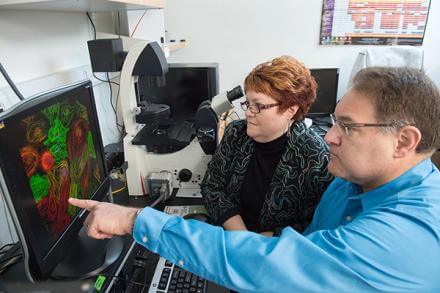|
Our laboratory uses stem cell, molecular biology, neuroanatomical and electrophysiological techniques to study mechanisms underlying 1) epileptogenesis (the development of epilepsy), 2) adult neurogenesis, 3) brain repair and 4) SUDEP (Sudden Unexpected Death in Epilepsy), the most devastating complication of epilepsy.
To model genetic epilepsies, we use patient-derived or CRISPR gene edited human pluripotent stem cells (hPSCs), cerebral organoids and also in vivo CRIPSR gene editing via in utero electroporation/viral vector injections in rodents. We apply electrophysiological analyses to 2-D and 3-D hPSC cultures, including multielectrode array recordings. We also study SUDEP mechanisms using patient induced pluripotent stem cell (iPSC)-derived cardiac myocytes. Separate from the laboratory, Dr. Parent directs the Human Stem Cell and Gene Editing Core to assist other laboratories in disease modeling with hPSCs. To investigate the regulation and function of adult hippocampal neurogenesis, and the involvement of aberrant adult neurogenesis in temporal lobe epilepsy (TLE), we use genetically modified mice, rodent chemoconvulsant TLE models, viral birthdating and tracing techniques, and chemogenetic tools to interrogate brain function. Our laboratory also studies adult neurogenesis and brain repair mechanisms using brain injury models in adult zebrafish, including lineage tracing and gene manipulation in transgenic zebrafish. Our goals are to 1) elucidate mechanisms of brain development and epileptogenesis to develop precision therapies for rare genetic epilepsies; 2) advance knowledge about the role and regulation of neural stem cells in the adult vertebrate brain, and 3) to use this knowledge to devise brain repair strategies based on the manipulation of endogenous or transplanted neural precursors. |
Sources of Funding
Recent News

Lab dinner at the 2023 American Epilepsy Society Annual Meeting in Orlando, December 2023. What a great night!
|
Julie Ziobro was recently awarded a Research and Training Fellowship for Clinicians from the American Epilepsy Society and PCDH19 Alliance. Her grant is entitled: Mechanisms of PCDH19 Clustering Epilepsy.
Louis Dang recently received a K08 award, entitled: The Role of STRADA in Epileptogenesis and Brain Malformations.
|
Jack Parent and Lori Isom recently received an NIH Epilepsy Centers Without Walls U54 Grant as co-Principal Investigators. This highly collaborative project, entitled Epilepsy Multi-platform Variant Prediction (EpiMVP), uses in vitro and in vivo models and a machine learning-driven prediction tool to determine the pathogenicity of genetic variants of uncertain significance (VUS) for a specific set of epilepsy genes. They are collaborating on the project with many outstanding investigators and institutions, including Gemma Carvill (Northwestern), M. Elizabeth Ross (Weill-Cornell), Scott Baraban (UCSF), Heather Mefford (St. Jude's), Santiago Schnell (Notre Dame), Vanessa Aguiar-Pulido (Miami) and Yu Wang and Michael Uhler (University of Michigan).
|



















